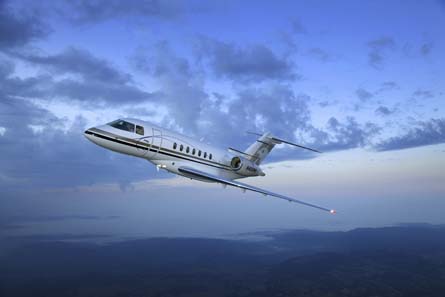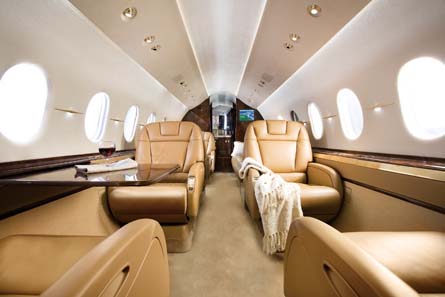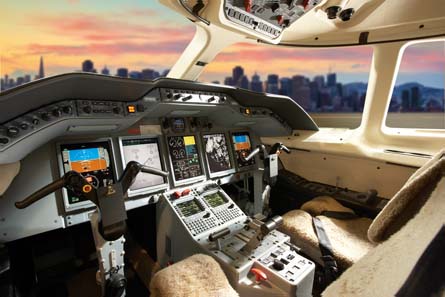On its launch in 1996, as the Horizon, the Hawker 4000 was pitched as the pioneer of a new super mid-sized segment. After numerous delays, the 4000 received type certification in June 2008, seven years later than planned, and entered a well-populated segment against offerings from Bombardier, Cessna, Embraer and Gulfstream. Three years ago, I was fortunate enough to fly an early production 4000 to see how it stacked up. At the time, I remarked that the 4000 was a real value proposition; offering a load-and-go capability and performance on par with other super mid-sized aircraft. Since then, Hawker Beechcraft (HBC) has continued to refine the 4000 to further enhance its value.
SOFTWARE UPGRADES
HBC has delivered some 46 Hawker 4000s to customers, with the latest deliveries incorporating the Block-Point upgrade package. The package consists primarily of software upgrades and enhancements as well as some actual hardware modifications. On the hardware side, the 4000 now meets the more stringent fuel-tank ignition prevention rules mandated by FAR 25.981, Amendment 102, and is the first Part 25 business jet to do so. Single-engine performance capability is also improved, with take-off thrust allowed for 10 minutes, up from five minutes, in a one engine inoperative (OEI) situation. Highlights of the software upgrade include enhancements to the flight management system (FMS), an electronic checklist and electronic maps and charts. Operational safety has been greatly enhanced with the addition of a Honeywell-sourced Runway Awareness and Advisory System (RAAS). All delivered 4000s will be upgraded the Block-Point standard at HBC's expense.
 |
|---|
| © Hawker Beechcraft |
Flight International put an upgraded 4000 through its paces on a flight from San Diego to San Francisco. The preview aircraft, registration number N400MR (serial number 12), was a customer aircraft that had just come out of the upgrade process, in which its cabin was completely refurbished to give the customer a cosmetically new aircraft.
ROBUST SYSTEMS
During the pre-flight briefings, lead sales engineer Patrick Buckles and senior demonstration Captain Mark Danin enumerated the 4000's features. HBC's design philosophy has yielded an aircraft with systems more akin to large cabin business and transport category aircraft. The flight controls mix conventional manual controls and fly-by-wire (FBW) components. The elevator and ailerons are cable/push rod surfaces, the spoilers and rudder FBW.
FBW technology for the rudder brings distinct benefits: pedal forces can be set to low levels and yaw trim accomplished without an aerodynamic tab. Two independent hydraulic systems and a backup emergency system ensure the rudder is always powered. In addition to hydraulic power, FBW controls require reliable sources of electrical power. Primary electrical power is supplied by two engine-driven generators with secondary power provided by two lead-acid batteries. Additionally, the APU's generator can provide electrical power in-flight at altitudes of up to 34,000ft. While the aforementioned electrical arrangement is nothing out of the ordinary, the 4000's standard hydraulic motor-driven generator can provide electrical power even should both engine-driven generators fail.
 |
|---|
| © Hawker Beechcraft Cabin height reaches 1.83m |
The robust nature of the 4000 is not just limited to its hydraulic and electrical systems. Dual air cycle machines (ACMs), a feature not available on the Challenger 300, provide increased dispatch reliability. Should an ACM fail, the 4000 can stay at altitude, a very useful capability for long-range over-water flights. Additionally, it enhances dual-zone cabin/cockpit temperature control. The greenhouse effect of cockpit windows can make temperature demands for cabin and cockpit quite different, and the 4000's dual-zone temperature control should help both keep passengers and pilots comfortable. System robustness is reinforced by the avionics package. The 4000's standard equipment includes dual inertial reference systems, dual global positioning systems, dual flight management systems and dual full authority autothrottles (ATs).
COMPETITIVE CABIN
I followed Danin as he conducted the pre-flight walk-around inspection on the ramp at Lindbergh Field (KSAN). While I had flown the 4000 before, I still marvelled at the overall fit and finish. The super-critical wing is of conventional aluminium construction with single piece top and bottom skins. Built by Fuji in Japan, it is assembled into a single piece that attaches to the composite fuselage at six points. The fuselage was glass smooth, with no unnecessary protrusions. Built in three sections, two splice bands (overlap joints) over the wing showed where they were joined. While it was not obtrusive on the aircraft I had flown three years prior, continued improvements had reduced the thickness of the overlap joint to the point that it was only noticed if looked for.
Entry into the aircraft was via a plug-type door with five integral steps. The spacious cabin is 7.62m long from the cockpit door to the aft bulkhead of the rear lavatory compartment. The 4000 has a true stand-up cabin with a flat floor and a 1.83m high ceiling. HBC lists a cabin width of 1.97m at the sidewalls, a figure slightly less than the 2.19m listed by Bombardier for the Challenger 300. The armrests of the 300's seats are wider than the 4000's however, negating any "paper" width advantage. While the Hawker and Challenger offer comparable spacious and comfortable cabins, Gulfstream's G280 will accelerate the space race with a cabin longer and taller than either's. The preview aircraft's cabin featured a three-seat divan in place of two of the standard configuration's aft club seats. Counting the belted lavatory, 10 passengers can be accommodated.
 |
|---|
| © Hawker Beechcraft The 4000 now has a totally paperless cockpit |
Solid sliding wood veneer panels separate the cockpit from the forward galley area. The physical layout of the cockpit, unchanged from my earlier flight, featured a display (203mm x 254mm) Honeywell Primus Epic avionics suite. Once I was strapped in the left seat, the throttles and Hawker signature ram horn yoke fell readily to hand. The outboard-mounted touch pad cursor control device (CCD), similar to the Boeing 777's, fell readily to hand. As on my previous flight, I found CCD use to be intuitive with ergonomics on a par with the CCD used in Gulfstream's PlaneView avionics system. Initialising the FMS was a snap, the inertial navigation systems having been aligned prior to the walk-around inspection. Our aircraft had an electronic checklist, a feature not available on my prior flight. Another enhancement in the upgraded avionics suite is FMS-computed take-off and landing performance data. Each engine reached IDLE less than 35s after the FADEC-controlled start using bleed air from the tail-mounted APU.
On release of the parking brake a slight throttle bump was all it took to start the 4000 rolling. Unlike most business aircraft I have flown where the rudder pedals have some nose-wheel steering (NWS) control, the 4000's FBW NWS (+/-70° authority) is controlled by the tiller. During large turns, tiller use was intuitive but for fine corrections on straight taxiways my instinctive pedal inputs were useless.
With the Block-Point upgrade, the 4000 now has a totally paperless cockpit, and during the taxi our position was mapped on the multifunction display's airfield diagram. Nearing the approach end of the runway the Honeywell RAAS announced, "Approaching 27". The RAAS system is a software modification to the enhanced ground proximity warning system that uses GPS-derived position and stored airfield data to increase runway safety. On the runway, the RAAS announced, "On Runway 27". Had we entered the runway at an intersection too far down-field to execute a takeoff, as defined by the operator, the RAAS would have announced, "Distance remaining" after entering the runway. Had we ignored the advisory and started the take-off, passing 40kt ground speed the RAAS would have announced, "Caution: short runway, short runway". The RAAS should reduce the likelihood of runway incursions; the short-runway caution mode may prevent take-off from an unsafe position.
Once cleared for take-off I released the brakes and pushed the throttles forward. Danin had armed the ATs, and they rapidly set take-off thrust. Acceleration was brisk for the 31,900lb aircraft, six occupants and 7,000lb of fuel. Danin guarded the yoke as I used the NWS tiller to stay on centre-line. As the rudder became effective, passing through 60kt indicated air speed, Danin transferred control of the yoke to me. Rotation forces at 127kt were light as I pulled the nose up to a 12° take-off attitude. During the clean-up and acceleration to 250kt I found the yoke trim rate a bit slow in keeping up with changing forces. I manually followed the flight director (FD) guidance in the primary flight display as we tracked the departure procedure. Roll forces were higher than I would have liked, but not objectionable. The dual yaw dampers allowed me to keep my feet on the floor during rolling manoeuvres.
Passing 10,000ft mean sea level (MSL) I lowered the nose and the 4000 accelerated to 280kt. That speed was held until a climb Mach of 0.78 was captured passing 26,500ft MSL. We reached our cruise altitude of FL400 about 16min after brake release. This performance lends credence to HBC's claim that a maximum gross weight 4000 can reach FL430 in 25min. Once level, I used the ATs to attain and hold M0.82 high-speed cruise. At 250kt indicated air speed the resultant true airspeed, at ISA +2°C, was 474kt with a total fuel flow of 2,030lb/h. Next I used the speed brakes to rapidly slow the aircraft to a long-range cruise speed of M0.78. At a true airspeed of 447kts total fuel flow was 1,770lb/h. I noted the 9.6psi differential pressurisation system was holding cabin altitude at 4,700ft. On long legs, a low cabin altitude has been show to reduce fatigue, a handy feature for the Hawker as it has an NBAA IFR range of 3,190nm/5,908km with four passengers. At M0.78, the cabin-deck angle was just slightly above level, easing movement through the cabin. The noise levels permitted conversations at a normal level.
RNAV APPROACH
While our destination was San Francisco, to conduct some practice approaches we initiated a descent to San Jose International Airport just 30nm to the south-east. Danin helped me load the RNAV GPS Y approach, and I especially liked not having to use paper charts in the now paperless cockpit. I used the AP and ATs to guide the aircraft as we followed ATC vectors to the final approach portion. The AP did an excellent job of tracking the desired lateral and vertical paths, while the ATs accurately held the approach speed of 120kt (flaps 35°). When the audible "Minimums" call was heard, I executed missed approach and manoeuvred the 4000 for a visual circuit. Established on downwind, Danin pulled the left engine to IDLE, to simulate an engine failure. At a single engine approach speed of 132kt (flaps 20°) less than 5kg of rudder pressure was needed to maintain co-ordinated flight on final approach. With the higher approach speed the aircraft floated a bit down the runway, before touching down for the first part of the touch-and-go manoeuvre.
Rolling down the runway, Danin set the flaps to 12° and reset the trim as I advanced both throttles. It was reassuring to have the RAAS call out the remaining runway length as I waited for Danin to call, "Rotate." Once airborne and cleaned up, NORCAL approach control provided vectors to RWY28R at San Francisco. I hand-flew the aircraft on a visual approach, using the instrument landing system to back it up. The full-stop landing was flown with flaps 35°. After touchdown, the spoilers automatically extended and I deployed the thrust reversers. Shutdown and post-flight flows were easily accomplished after my 1h 39min block-to-block flight.
Priced just under $23 million, the Hawker 4000 offers a stand-up cabin and can fly eight passengers from Los Angeles to Honolulu in splendid comfort. After having flown the 4000 shortly after customer deliveries were started three years ago, I remarked that it was a solid performer and was the value leader in the super mid-sized segment. Since then, with its Block-Point upgrade package, HBC has added an FMS-based performance computation capability, electronic charts and an electronic checklist to an aircraft that features surprisingly robust systems. It is not the largest, fastest or longest-range super mid-sized business jet, but it might just be the best value.
Source: Flight International
















